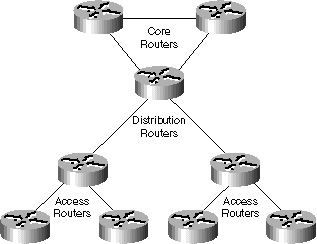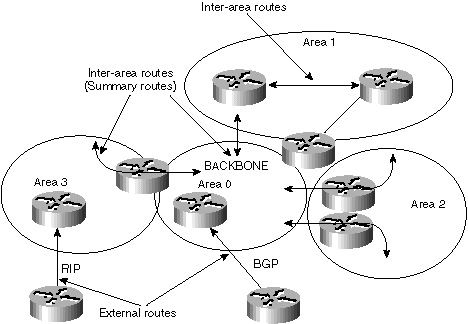The Fundamentals of OSPF Routing Design
Using Tunable OSPF Parameters There is a group of tunable OSPF parameters that can help you design an area that will more readily meet your network’s specific needs. All of these commands and their associated values generally default to good values. If you are considering changing them, it is good practice to change them in all routers.
The tunable OSPF parameters are as follows:
Critical Aspects of Area DesignThe two most critical aspects of designing an area include determining how the area is addressed and determining how the area is connected to the backbone. Areas should have a contiguous set of network and/or subnet addresses whenever possible. You can have an area with any combination of networks and subnets, but it is strongly discouraged. Whenever possible, you should have an area consist of grouped networks and subnets so that route summarization can be easily accomplished. Without a contiguous address space, the implementation of route summarization is impossible. The routers that connect an area to the backbone are called ARBs. Areas can have a single ABR or they can have multiple ABRs. In general, you should have more than one ABR per area to minimize the chance of the area becoming disconnected from the backbone. Designing the Backbone AreaThe OSPF backbone (also known as area 0) is extremely important. If more than one area is configured in an OSPF network, one of these areas has to be area 0. When designing networks, it is good practice to start with area 0 and then expand into other areas later on. To summarize, the OSPF backbone is the part of the OSPF network that acts as the primary path for traffic that is destined to other areas or networks. Accepted network design theory recommends a three-tiered approach (see Figure 5-8). This theory states that there should never be more than three tiers with a maximum of six router hops across the farthest points of the network. This type of design suits OSPF very well because of its area concepts and need for hierarchical routing. This design also reduces convergence time and facilitates route summarization.
Backbone Design Golden Rules You should stick to the following guidelines when designing an OSPF backbone (area 0):
The backbone has to be at the center of all other areas, that is, all areas have to be physically connected to the backbone. The reasoning behind this is that OSPF expects all areas to inject routing information into the backbone and, in turn, the backbone will disseminate that routing information into other areas. Figure 5-9 illustrates the flow of routing information in an OSPF network.
In Figure 5-9, all areas are directly connected to the backbone. Stability and redundancy are the most important criteria for the backbone. Keeping the size of the backbone reasonable results in stability. This is very desirable because every router in the backbone needs to recompute its routes after every link-state change. Keeping the backbone small reduces the likelihood of a change and reduces the amount of CPU cycles required to recompute routes. Redundancy is important in the backbone to prevent partition when a link fails. Good backbones are designed so that no single link failure can cause a partition (that is, the backbone becomes isolated). OSPF backbones must be contiguous. All routers in the backbone should be directly connected to other backbone routers. Avoid placing hosts (such as workstations, file servers, or other shared resources) in the backbone area. Keeping hosts out of the backbone area simplifies internetwork expansion and creates a more stable environment because a host’s normal operation (morning/evening, power up/down) will cause unnecessary LSA traffic. Virtual Links: Bane or Benefit? OSPF includes the concept of virtual links. In the rare situations that a new area is introduced that cannot have a direct physical access to the backbone, a virtual link will have to be configured. A virtual link creates a path between two ABRs that are not directly connected. Accepted network design theory considers the use of virtual links the result of a poorly designed backbone. A virtual link is able to connect an ABR to the backbone (area 0) even though it is not directly connected (see Figure 5-10). Through the use of a virtual link, which is similar to a tunnel, this can be accomplished.
Some of the characteristics and suggested uses for virtual links include the following:
|
EAN: 2147483647
Pages: 200


